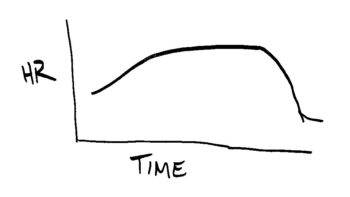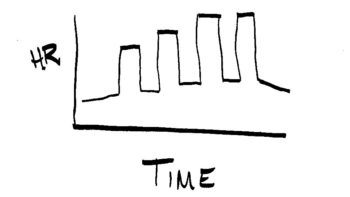Because we’re all pressed for time in our lives, I want to set you up to get the most results in the least amount of time from your workouts. In the case of cardio workouts, the best way to do that would be interval training.
High-intensity interval training (also known as HIIT) has been used effectively by athletes, notably runners, for decades. But it’s not just for high-level athletes — interval training is absolutely the best and most efficient way to train your cardiorespiratory system, regardless of your level of fitness.
Most people don’t incorporate intervals into their training. When they go for a walk or a run, they head out and maintain a consistent, moderate pace. Here’s what that looks like on a graph showing heart rate (HR) over time:

But with interval training, the goal is to vary the intensity of your workout, going back and forth between hard and easy efforts multiple times. Here’s the graph of what that looks like:

Yes, intervals can be hard. But they don’t have to be. They take experimentation, practice and experience. It’s up to you to make them work for you. The “easy” and “hard” effort levels are relative to you and your own capabilities, so If you’ve never done intervals before, make your hard efforts just a little bit harder than normal. Just experiment with it a bit.
There are many ways to modify intensity in an interval workout, and I’m going to talk about each of them here (and in the video at the top of this page) so that you can incorporate them into the workouts you’re trying at home or the workout plans you’re building from scratch.
It’s important to remember that there is no one right formula for this. It all depends on how long you have, what you’re willing to do that day, what you’re training for, and whether you’re seeing results from the intervals you’re doing.
The universal applicable factor for all HIIT workouts is that they must contain a hard effort (the harder the better), followed by an easy effort… repeated. Everything else can be varied.
So… let’s dive in.
First, lets talk about the different variables you can adjust in intervals.
- Speed: How fast are you going? This could be the speed at which you’re running, the cadence of your pedaling on a bike, or the speed at which your bike, rowing ergometer or elliptical is moving. It could also be the speed at which you are doing the reps of your bodyweight calisthenics (you can do intervals with things like burpees) or even the cable machines at the gym.
- Resistance: How much resistance to your effort are you feeling? On a treadmill, you’d increase resistance by increasing the incline. On an exercise bike, you’d up the level. Using weights? You’d increase the load.
- Heart Rate: Your heart rate is something that will be affected by both speed and resistance. It’s a simple total measure of your effort. It’s a great idea to get an idea of what different heart rates feel like for you, like what your heart rate is when you’re going at an easy pace, a moderate pace, or a hard pace. Once you know this, you can start to use your heart rate as a measure of intensity. (One thing to note: You can only really use this effectively if you’re wearing a reliable heart-rate monitor, which usually means one with a chest strap.)
The next three variables have to do with your workout, what you’re training for, and what you have time for:
- Duration of effort
- Duration of rest
- Number of intervals
Here are some rules to live by:
- Generally speaking, the longer the effort, the more difficult it is to maintain a hard pace. So if you’re just getting started with interval training, it’s a good idea to start with shorter intervals (like 30 seconds).
- It’s important to feel recovered between hard efforts, or at least partially so. Again, if you’re just getting going with intervals, you’ll want to use a rule of 2 to 3 times the duration of the hard interval for recovery. So if you go hard for 30 seconds, you want your recovery to be 60 to 90 seconds. Of course, the speed that you will recover partially depends on how hard you went during the hard effort.
- The number of intervals you do in a given workout is really governed by how much time you have. There is no wrong number. Have fun with it. Experiment. Try different things.
Now let’s set the stage with some real-world examples.
Every interval workout should start with a warm-up and end with a cool-down. So your available time is definitely a factor. But remember that even with only 10 minutes, you definitely have time for an effective interval workout.
Also remember that the bigger the differential between your effort and the recovery, the better. That means when it’s time to go hard, go hard! Hard for 30 seconds is different than hard for 2 minutes, and you’ll figure that out with practice.
The following examples are all approximately 10-minute workouts. Remember, you can modify or change these depending on your level of fitness, experience, and how much time you have for a workout.
If you’re playing the Whole Life Challenge, workouts like these are a great way to fulfill your daily 10-minute exercise requirement, while also maximizing the benefits you get from that exercise.
Example 1
2 minute warm up
10 x 15 seconds hard, 30 seconds easy
1 minute cool down
Example 2
2 minute warm up
5 x 30 seconds hard, 1 minute easy
1 minute cool down
Example 3
2 minute warm up
3 x 1 minute hard, 2 minute easy
Last 2-minute easy interval is the cool down
Example 4
1 minute warm up
3 x 2 minute hard, 1 minute easy
Last easy minute interval is the cool down
For more exercise and Whole Life Challenge-related tips, follow me on Instagram (@andypetranek). I’ll be doing regular Q&As there — look for them in my Instagram stories!





